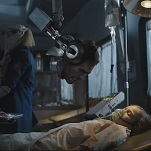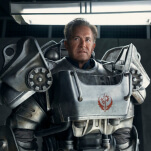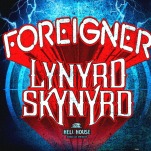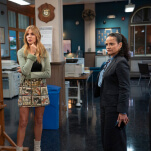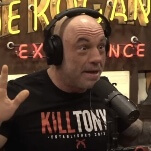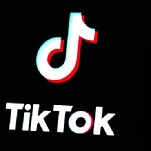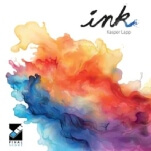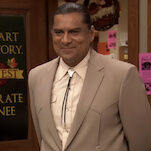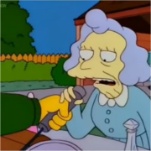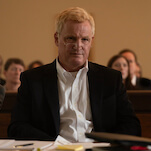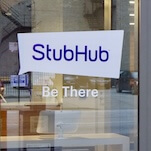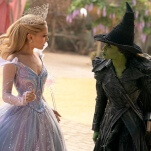Product placement is not always met this way: Though it is no secret soap operas once existed to sell soap, and that advertising revenue drives television decision-making, the presence of products in shows has often been met with derision. ABC Family’s The Fosters, for instance, has struggled all season trying to make it seem natural for characters to say the entire name of products—like “Kindle Paperwhite”—when any regular human being would use a generic term. And most viewers have a product-placement horror story—like Suburgatory’s Microsoft Surface tie-in—that will haunt them until the end of time.
The result was Subway becoming a character in the show, both literally—in the form of the “corpohumanized” Subway—and figuratively, as a barrier Shirley must overcome to make her sandwich shop a reality. “Basic Story” represents the return of Subway—most likely under the same terms—as a corporate force hell-bent on invading Greendale. Harmon’s shrewd negotiation of brand and narrative may ultimately satirize traditional forms of product placement and corporate brandspeak, but Subway has given up control in favor of avoiding the stigma attached to being poorly integrated into a television show, while nonetheless maintaining a branded presence in the audience’s minds.
The term “product integration” largely replaced “product placement” to reflect brands’ and writers’ effort to bridge the distance between creativity and marketing in a practice that is often forced onto series by networks and channels. Similar “creative” brand integration efforts appear in shows like HBO’s Silicon Valley, which helped sketch out the idiosyncrasies of dot-com billionaire Peter Gregory by having him dissect the entire Burger King product lineup. Under the right terms, writers can successfully bridge creative goals and commercial imperatives so a brand within a scene or storyline does not immediately welcome a negative audience response.
We have come to the point in evaluating television content where we are neither surprised by nor—under the right circumstances—put off by the idea that a brand has purchased an integrated advertisement within a program. But what happens when it’s the other way around? What happens when companies opt for the complete control of producing television-like content to serve their own interests, rather than giving control to writers like Harmon? How do viewers perceive that programming, and how should critics confront it? Is it even programming at all?
Mark also happens to work at Subway. This detail is not ultimately important to the story; he could be working at any fast-food chain, and the storytelling would be identical. (Although the use of the word “fresh” might decrease by 400 percent.) Mark works at Subway, though, because The 4 To 9ers is produced by Content & Co., a “brand studio” hired by Subway to produce a scripted webseries to promote its products. As Content & Co.’s website notes, “Teens are the mainstay of the [quick-service restaurant] industry. But Teens are hard to please and are rarely open to what brands tell them. So rather than sell Subway to this audience, we created a show that celebrates them.”
Such agreements are possible in an age where producers—and the brands they work for—no longer need networks or channels to reach audiences. The 4 To 9ers lives on Hulu, alongside traditional television content like Community, rather than in the mixed amateur/professional space of YouTube with other webseries. And compared to some of the company’s most blatant television product placement—See: Hawaii Five-0—Subway’s presence is subtle, although more pervasive through the characters’ uniforms and the restaurant backdrop.
The 4 To 9ers aims to simultaneously serve the Subway brand and engage with audiences as a traditional series or webseries would. Whether it succeeds is debatable; I found The 4 To 9ers amiably generic but ultimately forgettable. But any conversation that doesn’t start and stop with “Subway-produced webseries” is a victory for the company. The series’ ability to walk and talk like non-branded content is a point of pride for Subway, heralded in popular press comments about the program. The series’ success—drawn mainly from its presence on Hulu’s front page and promotion through Subway’s social media channels—even encouraged the company to shoot additional footage last spring, adding parent characters to appeal to a family audience and more closely resemble a broadcast sitcom. The company even greenlit a sequel, The Day Crew, which debuted last month and is releasing new episodes every Tuesday.
Subway’s recurring status as a “product antagonist” on Community signals an evolution of product integration, and the idea of a sequel to a branded webseries indicates that story is capable of remaining a priority within programming designed and executed by marketing firms. This was part of what drew my attention to the series: If this is getting a second season, should we be treating it like we’d treat other webseries? Is it possible that it has transcended its branding to tell stories viewers are connecting with on a meaningful level?
However, upon further investigation, I discovered The Day Crew isn’t actually a sequel to The 4 To 9ers. Despite the first series ending on a cliffhanger, The Day Crew follows a new set of characters working at the same Subway location while—presumably—the other characters are still in school. Although the series’ comic relief—the boss and the security guard—remains in place, and the show is picking up ancillary story threads from the first season, the new series follows recent college graduates working part-time jobs while figuring out what to do next.
The lack of narrative continuity could be because it’s difficult to convince young actors to continue working on a series produced by Subway when other opportunities await. The first season’s star, Ashton Moio, is a series regular on ABC Family’s Twisted, while female lead Galadriel Stineman is recurring on ABC’s The Middle. However, the shift in demographic could also be Subway’s conscious effort to expose its brand to a different age group, using the older stars and more “adult” love triangle to appeal to a college-aged audience. In the same way that the corpohumanized Subway was replaced when he was corrupted by Britta on Community, the original cast members of The 4 To 9ers were replaceable. The new models better reflect the data Subway is surely collecting from Hulu and its market research teams.
This choice makes it more difficult for Subway to claim The 4 To 9ers’ narrative exists for any reason other than keeping audiences engaged for six weeks while the series airs. It doesn’t need audiences to get connected with characters over longer periods, and has no reason to offer audiences closure or narrative satisfaction, because the videos exist primarily as a way to take advantage of young adults’ penchant for short-form online content, and to create a Subway-branded environment for this viewing. As much as the placement on Hulu and the claim to sitcom pedigree—populist sitcom pedigree, by way of Two And A Half Men and Growing Pains—suggest higher aspirations, The 4 To 9ers ultimately boils down to a way to push Subway sandwiches.
It’s not the only model available, though. Whereas The 4 To 9ers is designed as short-form web content, Farmed And Dangerous is a half-hour comedy featuring legitimate star power. In the show, Ray Wise plays a corporate spin doctor asked to sell the public on the increasingly evil practices of the commercial farming industry. Farmed And Dangerous also appears on Hulu and is the production of a brand, in this case Chipotle Mexican Grill, working with producer Piro.
However, viewers need to pay closer attention to realize this. Although Farmed And Dangerous appears on the “Chipotle Mexican Grill” page on Hulu, and is branded as an “Original Chipotle Series” as though the restaurant chain is its own cable channel, Chipotle is strikingly absent within the series itself. Outside of a brief throwaway during a collection of fake viral stop-motion animated videos in the second episode, Chipotle branding never appears in the series. While the Subway videos each begin with an ad for Subway’s latest product—currently the Flatizza—the Chipotle videos begin with Wise, in character as Buck Marshall with no Chipotle branding on-screen, warning viewers not to be sucked into the series’ satire of commercial farming and—in one case—suggesting they go watch something else on Hulu instead. (“Avoid Food Inc., though. More hippie propaganda.”)
Farmed And Dangerous follows the Romeo And Juliet-style tragedy of a farmer’s son and a corporate spin doctor’s daughter, Chip and Sophia. They are brought together by their love of sustainably grown tomatoes and torn apart by her responsibility to the corporate forces threatening his way of life. The corporate satire side of the series plays out like the send-up of Veridian Dynamics in ABC’s Better Off Ted, and the series is more stylistically interesting than expected. Someone clicking through Hulu without paying attention might not even realize the series was actually produced by Chipotle, which is both a mark of legitimacy and—presumably—a disadvantage from a branding perspective. If people aren’t being reminded that they’re watching content produced by Chipotle, how does a series connect the brand and its audience?
Farmed And Dangerous is effectively an adult afterschool special designed to teach viewers about the dangers of industrial farming and the value of sustainable farming practices. While it has a narrative, it exists primarily to frame thinly veiled lectures detailing how industrial farms are endangering consumers. In episode two, Chip and Sophia engage in a drinking game that brings the characters closer together, but the drinking game is the two of them trading truths about their respective industries, a set of talking points that feels pulled directly from a hypothetical “19 Facts You Need To Know About Sustainable Farming” Buzzfeed list (which would probably be sponsored by Chipotle).
This serves Chipotle as evidence of its commitment to sustainable farming practices, something that separates Chipotle from other fast-food chains and which the company calls “values integration.” Chipotle uses the series as a platform to perform its progressive politics, which has created a different kind of backlash: Rather than drawing criticism for featuring its product, the company has drawn criticism for exaggerating industrial farming for comic effect, and distorting the facts in favor of its own position. But this type of controversy is a sign of Farmed And Dangerous’ success; the series works so hard to ignite this debate that the story stops dead at times so lessons can be imparted.
But how should those who cover the television industry confront a series like this? Unlike The 4 To 9ers, Farmed And Dangerous earned a review in Variety, and feature pieces from The New York Times, Time, and The New Yorker. In The New Yorker, the model is rightfully traced back to the early days of television, when brands like Kraft and Texaco sponsored and produced content for entire programs. However, few reviews of Farmed And Dangerous have considered it as a television narrative—few people are talking about the fates of the show’s characters, the development of the narrative, or the performances of its stars. Variety categorizes the series as having “more tang than one might have anticipated given the pabulum often churned out in ad-supported vehicles, yet which ultimately falls into a sort of narrative no-man’s land that’s neither fish nor fowl.”
And yet the series ends on a cliffhanger, which Chipotle seems intent on resolving. According to Chipotle’s chief marketing officer, those additional episodes will “end up on TV, probably on one of the cable networks.” In this, Chipotle sees Hulu as a way to gain easy access to spaces where television content is seen online so that it can successfully transition its content to more traditional avenues of television distribution. The 4 To 9ers hopes only to walk and talk as a lighthearted webseries, while Farmed And Dangerous aspires to be a prestigious cable satire: The choice to include a complete set of credits within the opening of each episode is a grasp at pay-cable legitimacy. And Chipotle makes sure to emphasize to The New Yorker that “the budget for the show is similar to, you know, any other high-quality cable-TV scripted show.”
This is all rhetoric, though not exactly empty rhetoric. Farmed And Dangerous is meaningfully distinct from The 4 To 9ers; it warrants closer investigation and signifies the continued evolution of the relationship between brands and program content. That being said, the goal of this rhetoric isn’t to create entertaining or engaging programming; instead, it’s designed solely to infiltrate existing discourses and legitimate marketing efforts in ways that will allow them to seep through the filters audiences have been honing in the decades since sponsored television was a reality, filters they use to sniff out Surface tablets and other cases of “egregious product placement.”
In Chipotle’s efforts to get viewers to imagine a world of sustainable farming—hence the use of Willy Wonka And The Chocolate Factory’s “Pure Imagination,” covered by Fiona Apple, as part of its “values-integrated” animated short The Scarecrow—the company is also imagining a world where its branded content can sit alongside a show like Silicon Valley without viewers batting an eyelash, a world where The A.V. Club will be covering the fourth season of The 4 To 9ers week-to-week in 2016. And while sites like Hulu have removed one of the gatekeepers holding back brands from achieving these goals, brands will have a tougher time convincing the ultimate gatekeepers—audiences—to embrace their series on the level they’re aspiring to.

